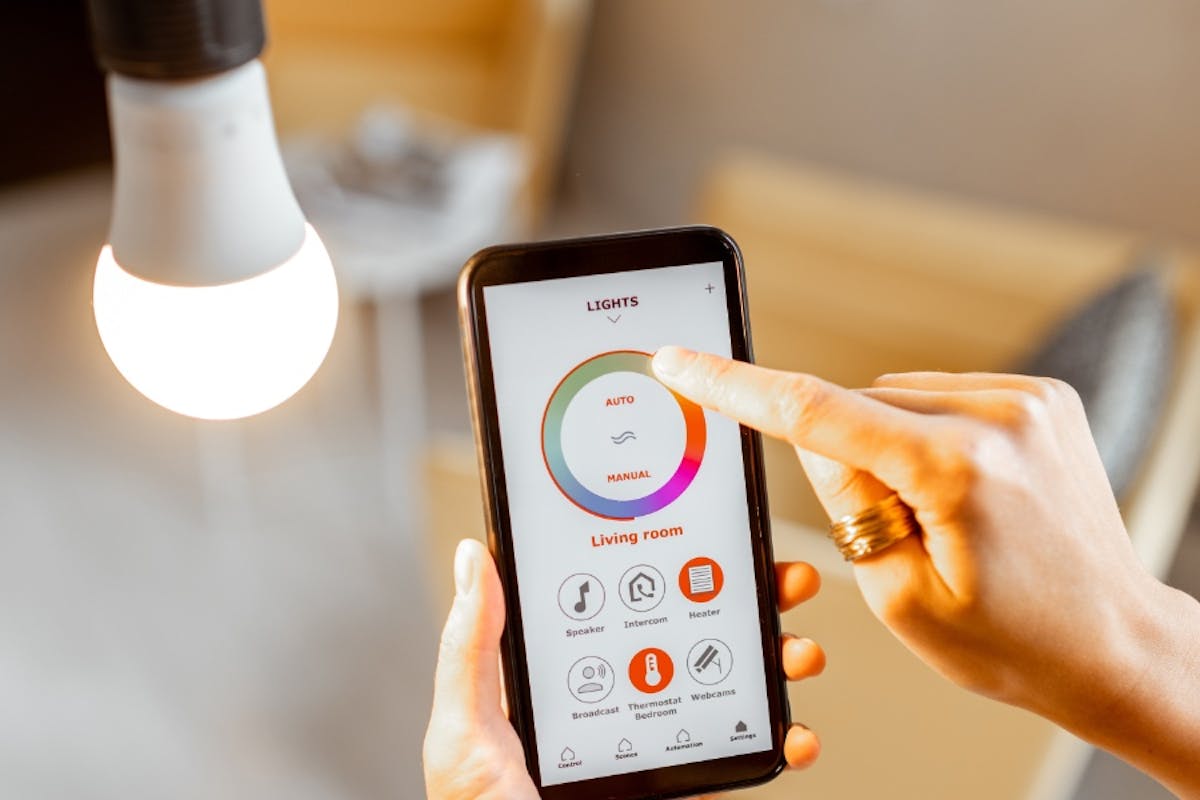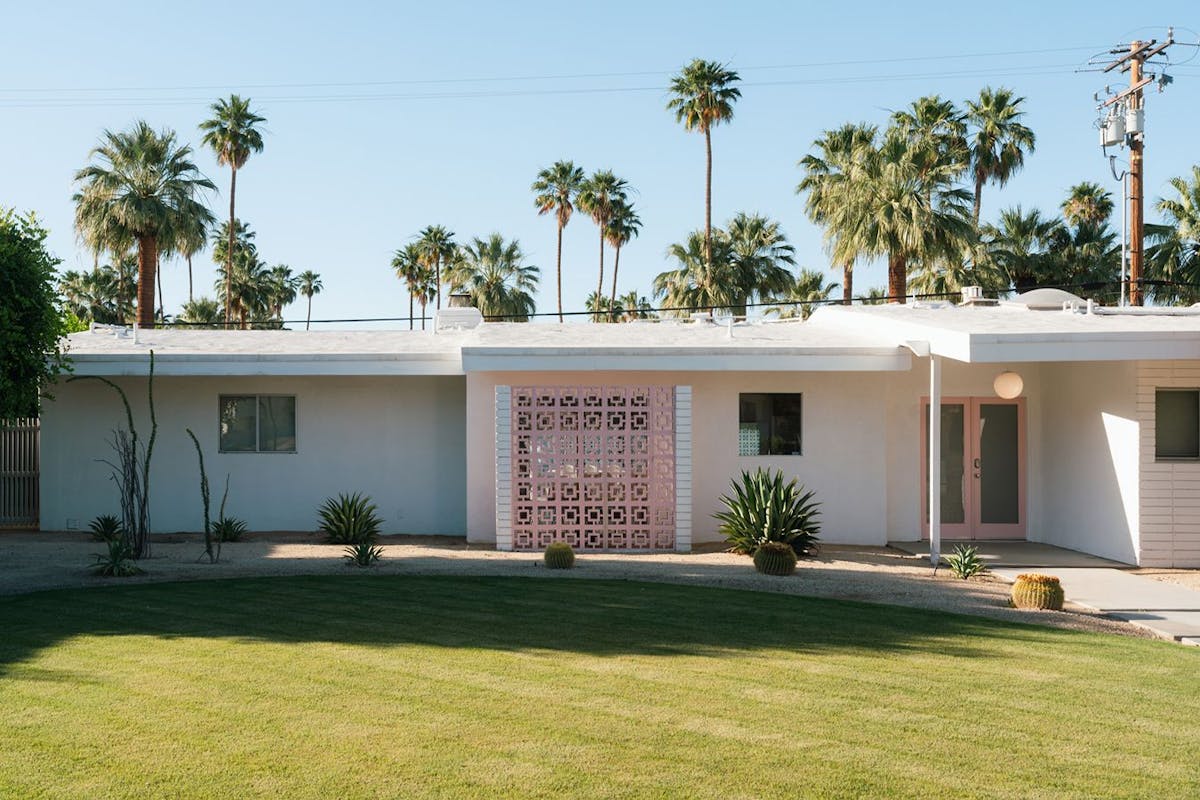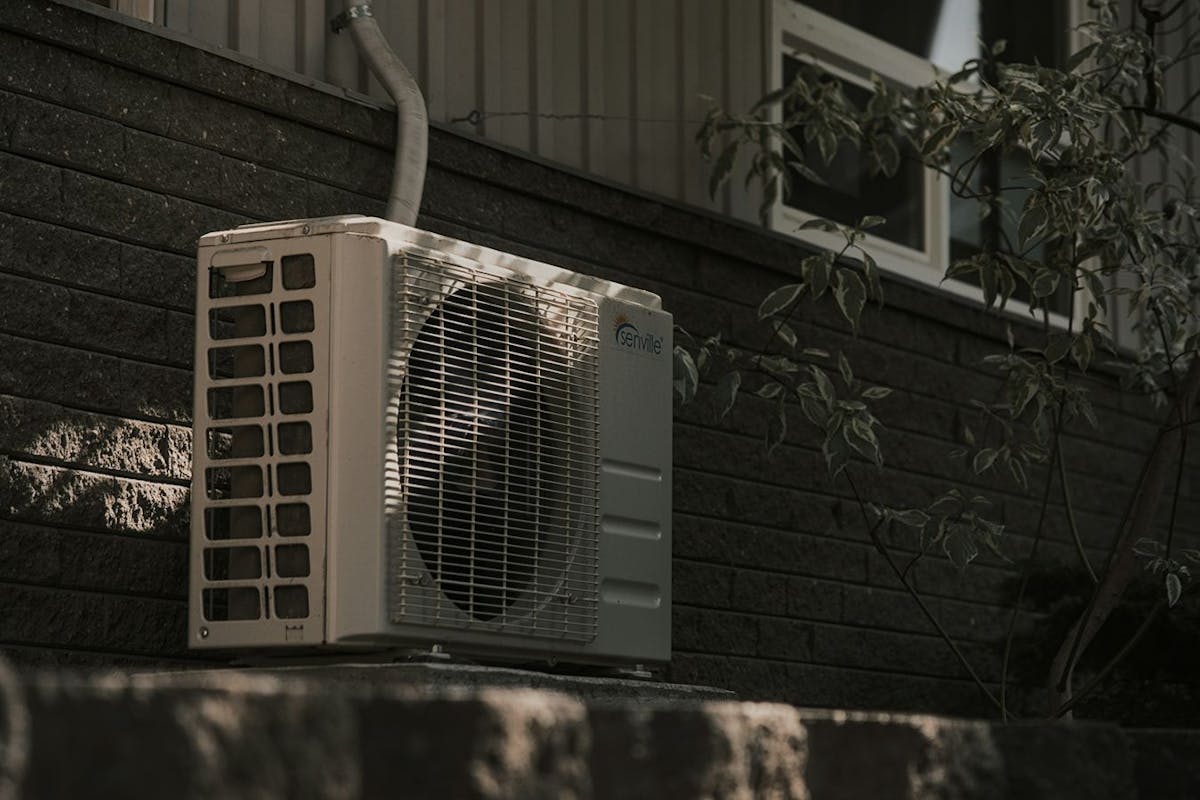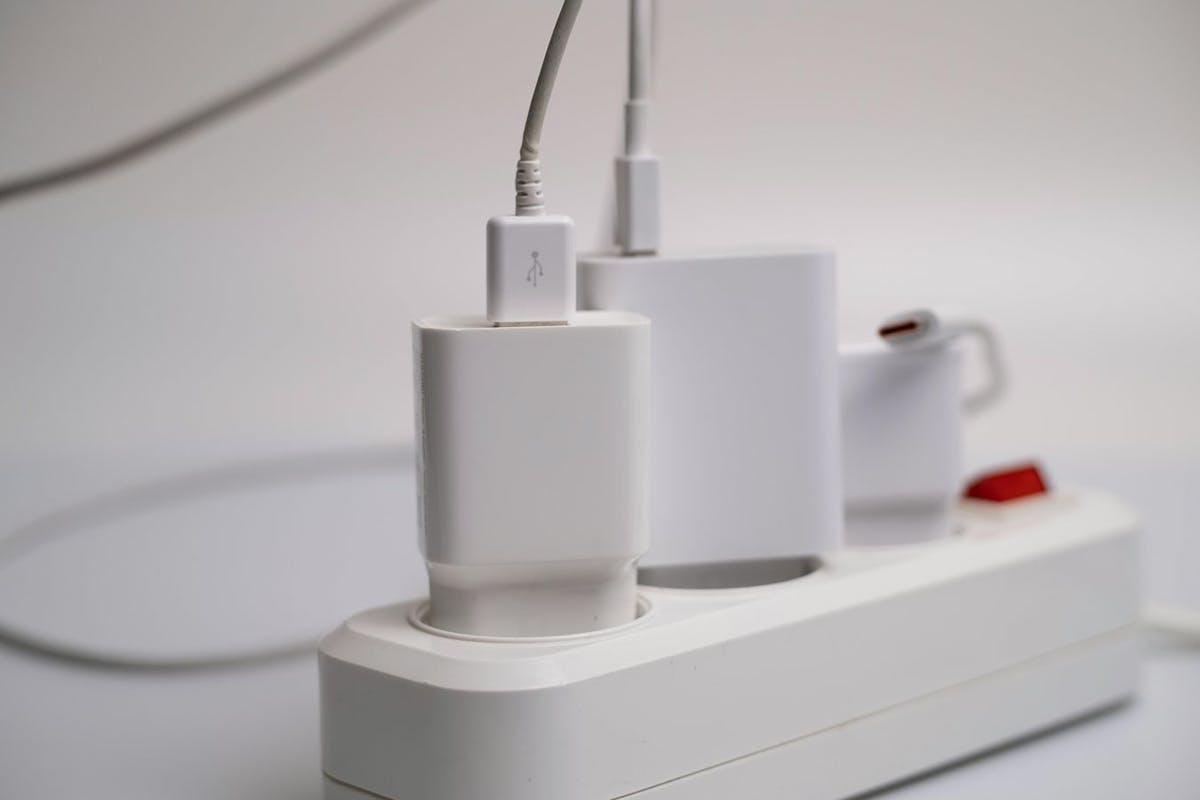Smart Lights: Fun and Stylish Updates That Could Save You Energy
Last edited

Author
Andrew Giermak
Solar and Electrification Writer and Editor

Editor
Ryan Barnett
SVP, Policy & New Market Development

What difference can one light in your home make? A better question, though, is how many lights and light bulbs do you have in your whole home? If those lights are older, each one could be a chance to save. Energy usage, style, and smart controls are some reasons to consider upgrading lights in and around your home.
Smart lights’ smart features such as remote/app control, scheduling, and creative aesthetic ideas, can reduce your energy usage and give you other positives you didn’t know you were missing.
See how much you can save with home energy changes
What are smart lights?
Smart lights are internet-connected light bulbs you can control from an app, a smart speaker, or smart home hub, like Amazon Echo or Google Nest. You can control them with your phone or your voice, when you’re at home or miles away. Many of them can change color and brightness or can coordinate in preset automations.
It's easy to see why people love smart lights.
- Smart lights provide a pleasant ambiance in the home.
- Smart lighting can be remote controlled.
- Smart bulbs can reduce energy use and save you money.
How smart lights work
While all smart lights use wireless tech to receive and send signals, different light bulbs use different communication methods.
Some use Bluetooth to connect directly with your smartphone. Others use built-in Wi-Fi to connect with your internet router. To control smart lights from any location in your home, you may need a central hub to seamlessly communicate between all devices. Opting for a Wi-Fi hub allows your smart light bulbs to communicate with your home’s internet more effectively.
In addition to Bluetooth and Wi-Fi, many smart light bulbs use smart-home-specific communication technologies like Z-Wave and Zigbee. In this case, you’ll need a central hub to act as a translator between your home’s internet and the smart light bulbs so they can communicate with each other. For example, Philips Hue Lights use Zigbee as the communication technology for their bulbs, so you need their Philips Hue Bridge hub to connect the bulbs to your internet and let your network speak that language.
How do smart lights save energy?
The light-emitting diode (LED) is one of today's most energy-efficient light technologies available. Top-notch LED light bulbs last longer, use at least 75% less energy, and give better lighting than CFL and incandescent bulbs.
According to the Department of Energy's projections, using LEDs could save up to a whopping 569 terawatt-hours (TWh) in energy usage compared to not using LEDs at all by 2035. To put that into perspective, 569 TWh is equivalent to the total annual energy output of at least 92 1,000 megawatt power plants.
Yet, smart bulbs go above and beyond the normal LED light bulb to enable additional features that can help you save more money. Here’s how smart lights work to bring savings to your home.
Smart lights use less electricity
When it comes to saving money on your home energy costs, every little bit helps. Different light technologies use different amounts of energy, and the current generation of LED light bulbs is approximately 75% more efficient than old-school incandescent light bulbs. Compare that to CFL light bulbs, which are only 25-30% more efficient than incandescent bulbs. In both scenarios, smart LEDs use less electricity and waste less energy as heat.
Smart lights last a long time
On average, an LED bulb lasts 15,000-50,000 hours, while a standard incandescent bulb's lifespan is 750-2,000 hours. Based on average household usage of 3-4 hours a day, an LED bulb can last 15 to 25 years, while an incandescent bulb might only last one.
Not only will you save on energy bills, you’ll help the planet by using less energy and generating less waste.
Lighting schedules reduce your usage
By putting smart home lights on a schedule, you'll ensure they're never left on when they don't need to be. This can save you money and energy in the short and long term.
Smart lights let you create rules for when they turn on and off. This could be by time of day or, in some cases, based on where your phone is. This can be really useful for outdoor lights, as well as specific rooms of the home where lights seem to be on all the time.
Simply connect them with Apple HomeKit, Google Home, Amazon Alexa, IFTTT, or another smart home system to build your schedule.
Turn off the lights when you leave
With CFLs or incandescent light bulbs, if you forget to hit the light switch as you leave, the lights stay on until you're back. That’s wasted energy.
Smart home lights have changed the game. You turn them off remotely or program your smart home system to turn off all the lights in the house using geo-location technology — if all the connected phones are out of the house, the lights turn themselves off.
Pair with other devices
You can pair your smart bulbs with hardware switches, sensors, phones, and other accessories for increased control and more frugal use.
For example, you can add special wireless smart switches that control the lights from different parts of the home that didn't originally have a wired switch.
You can use paired sensors to automate smart lights. With those sensors, your lights can do things like turn on when somebody walks into a room, touches a cabinet, or opens a door. Most smart bulb manufacturers sell motion sensors with their products, including the top-rated Philips Hue Motion Sensor.
In addition, you can use color-changing lights to create alerts based on other smart home sensors. Popular options include programming your bulbs to turn blue if there's a water leak or red if someone leaves an exterior door unlocked.
Track your energy usage
Many smart home devices, smart bulbs included, keep track of how much energy they use. This allows you to review usage data to see how much electricity you are actually using, which can reveal ways you can use less energy.
The new Palmetto app can track your home energy usage, plus see how home electrification, home solar, and new energy-saving devices can equal savings.
See how much you can save with home energy changes
How much can you save with smart lights?
Switching from incandescent or CFL light bulbs to LED bulbs throughout your home can result in savings from lower energy usage and the longevity of LED bulbs. LED bulbs last an average of 25 times longer than incandescent bulbs. Here’s a good rule of thumb: An average LED bulb adds about $1 to your energy bills every year compared to the $7 added by a comparable incandescent bulb.
Going to smart lights is an additional cost and potential savings are likely small or non-existent when compared to already using LED bulbs in conventional fixtures.
Smart lights typically cost more than standard LED light bulbs and you’ll need to include the cost of the bulb in your savings calculation, but you’re getting more than just light.

Do smart lights use electricity when off?
The short answer to that question is, “Yes, they do.” However, it’s important to understand the context.
Smart lights are “vampire devices,” which means they use electricity even when they're turned off or in standby mode. The reasoning is simple: In order to be turned on with your smartphone or any other smart device, the light bulb needs to be connected to Bluetooth or the internet. It takes electricity to maintain that constant connection so you can turn on the lights whenever you need them.
However, the amount of power a smart light uses in standby mode is very small and can be offset by the bulb's other benefits. A typical smart bulb only uses a few cents a month when turned off or in standby mode. It would take a long time for the power used by your smart bulbs to become dollars.
Types of smart lights
Smart home technology has evolved rapidly over the past few years. Today, a wide variety of energy saver light bulbs exist to suit many different users.
You can get bulbs with warm, neutral, and cool light color temperatures. You can also purchase bulbs in any color of the rainbow or any color on the daylight spectrum. You can get bulbs that change color and light temperature. The choices are endless.
Smart light bulbs vs. smart switches vs. smart plugs
When it comes to smart lighting, you have three main options from which to choose. Each has its benefits and drawbacks.
- Smart bulbs: Using actual bulbs is ideal if you want to control them individually or want to tweak the color of your home's lighting. Smart bulbs come in different sizes and shapes, so you're sure to find one for almost any fixture or lamp, whether outdoors or indoors. Compared to switches and plugs, bulbs give you the most benefits.
- Smart switches: When you want to control light bulbs operated by a light switch, smart switches are another option. They're particularly useful for switches that control several light bulbs at the same time. However, while they offer benefits like timing and scheduling, they typically don't do color changes. Switches have more features than smart plugs, but less than bulbs.
- Smart plugs: Smart plugs convert ordinary appliances in your home into smart ones. They do this by allowing you to control the power supply to the appliance through an app on your smartphone. To create a smart lamp, you can add a smart plug to any ordinary electrical outlet in your home and then plug in your favorite mood lighting. In terms of features, plugs only provide basic on/off control and energy tracking.
Smart light bulb shapes
When it comes to light bulbs, smart or not, people envision the classic “inverted pear” shape. It’s what most of us grew up using and what many of us still use today. But just like many other rapidly growing forms of home technology, energy saving light bulbs have evolved to come in a wide variety of shapes and sizes.
A Series (A15, A19, A21, A25): A-shaped bulbs (the “inverted pear” shape) are the standard for most home settings with A19 being the most common.
BR Series (BR20, BR30, BR40): BR simply stands for “bulged reflector.” These bulbs have a bulbous shape and tend to be shorter than the A-type. If you need wide-angled lighting in your home — for instance above the kitchen surface or in the hallway — we recommend the BR30.
E12: This type of bulb is known for its candelabra-style shape, making it perfect for more ornate light fixtures in formal dining rooms.
Of course, new technology often means new fashions. The vintage-looking Edison-style bulbs have had another day in the sun, and their exposed filaments and intricate designs place aesthetics front and center.
Light strips are another new smart light option, and can bring smart bulb benefits to low profile spaces, like under cabinets, or in an entertainment center to provide lighting that complements your movie.
Popular smart light brands
When you think about the best smart lights, there are many other brands out there vying for your attention, including:
- Lutron
- Sengled
- Wyze Bulb
- Ring Solar
- Ikea
- Fibaro
- Kasa Smart
- Eufy
- Nanoleaf
- Sylvania
- Insteon
- LIFX
- Aoetec
- Govee
- Phillips
- GE Cync
- Twinkly
- Wiz
Whichever of these companies you get your smart lights from, we recommend you buy everything from one brand so it all works together effectively and through the same app. This will be simpler than managing several apps at the same time.
Control smart lights with your voice
When you connect smart lights to a virtual assistant, whether on your smartphone or through various smart speakers, your lights listen to your voice commands. Just tell them what to do, and they'll do it!
All the major smart home assistants work with smart light bulbs and voice controls, including:
- Apple Siri
- Google Assistant
- Samsung Bixby/SmartThings
- Amazon Alexa
- Home Assistant
With these virtual assistants, voice-activated lights are no longer a thing of the future. Use simple commands to turn lights on and off, dim or brighten lights, change the color, and so much more. Some assistants even offer a helpful “Wake Up” feature to get you going in the morning.
How do you install smart lights?
For bulbs, it's as simple as taking out the old bulb and putting in the new one. Just don’t forget to install the correct app to connect the bulb to your preferred network.
With plugs, you just insert the smart plug into an outlet and then connect your device into the smart plug. After you install the app to control and monitor the plug, you're ready to go!
Smart switches can be a bit difficult to install if you aren’t a home improvement regular. You have to remove your old switch to add the new one, which means dealing with the electrical wiring of your home. We recommend having smart switches installed by a professional.
Also we advise you do not install smart bulbs on a traditional dimmer switch. Because the dimmer limits the amount of power the bulb receives, the smart communication method might not work without the necessary power.
How much do smart lights cost?
Smart light costs are coming down. In today’s market, a good smart bulb starts around $10. The price goes up depending on the number of features, the types of smart home devices it can connect with, and the quality of light it produces. For instance, if you want a bulb that can turn the light any color, you may have to spend $40 or more for a high-end model. Smart lights can save money (and benefit the environment) by reducing your energy consumption. Most immediately, smart lights can make your home a more comfortable, convenient, and fun place to be.
Another fun and easy way is with the new Palmetto app. With your home’s specific data and numbers, the app shows you how to use less energy which will save you money every month.
If you’re interested in other ways to make your home more efficient, you can learn even more with our free Savings Maximizer, where you can see an estimate of what your savings could be with other energy upgrades.
See what home electrification can do for you:
Frequently asked questions
Can smart lights save you money?
In some cases, yes. Because smart lights are LED, they’re highly efficient. Since they can be scheduled or switched off when you leave home, they can keep you from wasting energy. Whether you can save depends on what bulb they’re replacing, how much energy you’re wasting by leaving the lights on, and your local cost of electricity.
How are smart lights different from LED lights?
Smart lights are a type of LED light, but with additional features. They can change color, are app-connected, or can be set to specific schedules.
Do smart lights require Wi-Fi?
Most smart lights need to connect to wi-fi for setting programs or receiving instructions. Most smart lights function to some degree offline, to some degree if they are connected to Bluetooth, but not wi-fi, and to a full extent when connected to their home wi-fi network.
Are smart lights a security risk?
There are ways smart lights, or any smart devices in your home, can be a security risk. They are susceptible to hacks or cyberattacks. It is possible for a hacker to access data through a connection. You should treat passwords, log in info, and your private data the same with smart device accounts as with any account or device.


